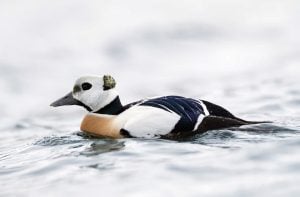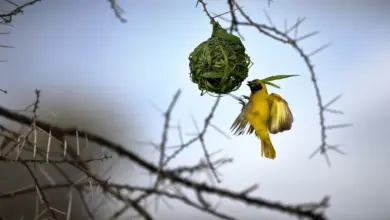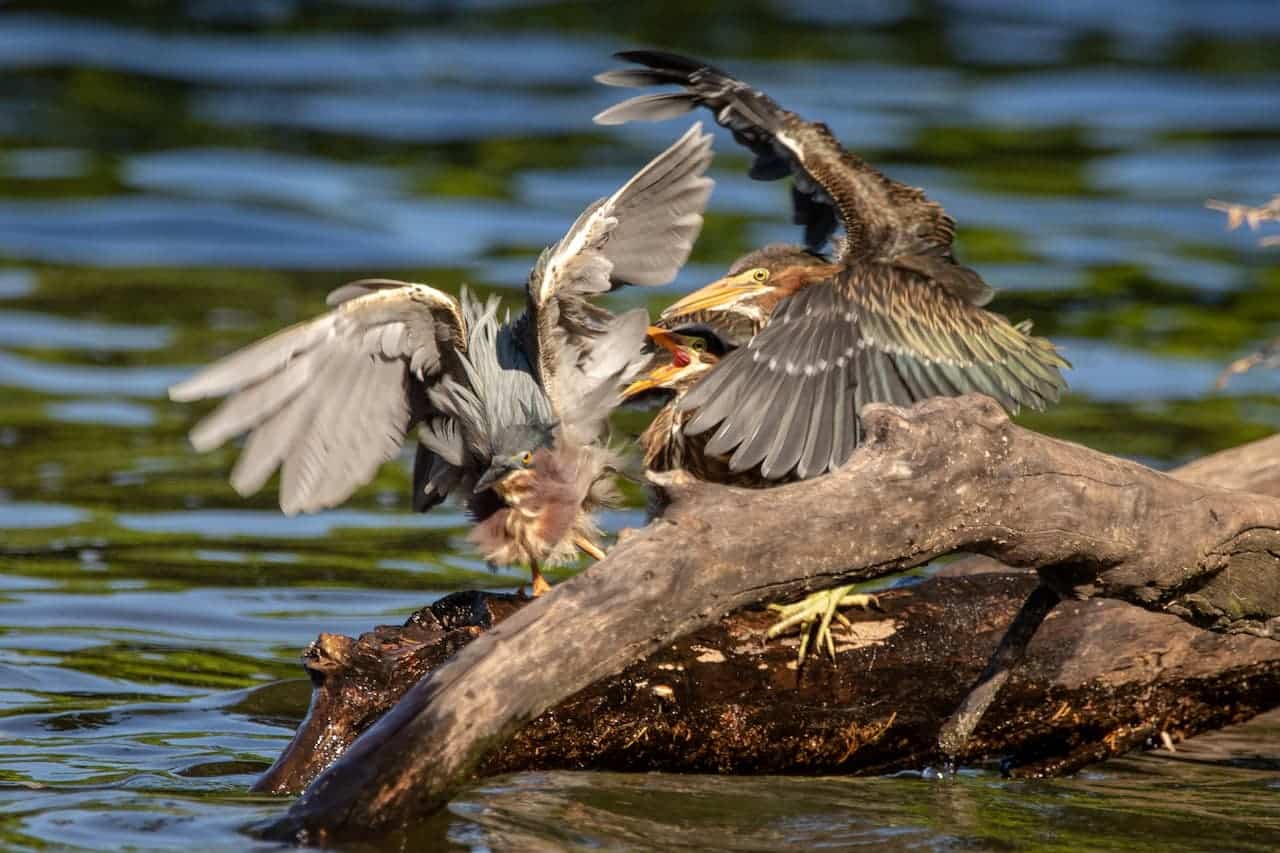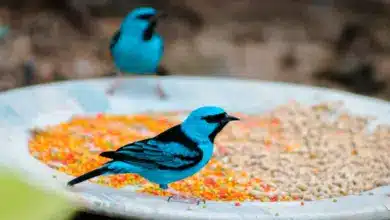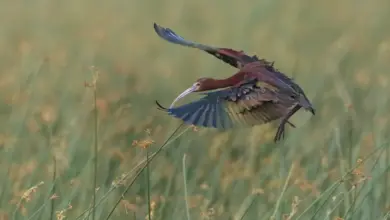Steller’s Eider Seaduck
Steller’s Eider Seaduck (Polysticta stelleri)
The Steller’s Eider Sea Duck (Polysticta stelleri) is a beautiful and distinctive sea duck named after the naturalist Georg Wilhelm Steller. This rare bird breeds in the Arctic tundra and migrates long distances to winter at sea.
The Steller’s Eider stands out among sea ducks with colorful plumage and unique behaviors. However, threats to its limited populations mean dedicated conservation efforts are needed.
The Steller’s Eider has a striking appearance and specialized adaptations that enable its niche as a subarctic diving duck. In this article, we will explore its identification, breeding behaviors, threats, and significance.
Steller’s Eider Seaduck Identification and Markings
The Steller’s Eider is an 18-20 inches long medium-sized diving duck with a stocky, compact body. The breeding male has a striking tri-colored plumage pattern of black on the back and tail, white shoulders, and a deep chestnut belly.
Iridescent patches on the sides of the head shine green and purple, catching the light. The breeding female is more subtly marked with mottled brown upperparts and a darker cap. She has a pale face patch surrounding her eyes.
Both sexes have a more subdued gray-brown overall appearance in non-breeding and juvenile plumage. The male still retains some darker back coloring when not breeding. This cryptic, nonbreeding plumage provides camouflage during the flightless molting period.
The Steller’s Eider has a long black bill that is powder blue at the base with a yellowish tip. Their feet are bright orange-yellow, giving them the alternate name “gold paddle spotting duck.” They have a very rounded head shape compared to other sea ducks.
Steller’s Eider Seaduck Breeding Habitat and Nest Sites
The Steller’s Eider is a highly northern species, breeding in the Arctic tundra zones. The main nesting range is along the northernmost coasts of Russia, from the Chukotka Peninsula to the New Siberian Islands bordering the Laptev and East Siberian Seas.
A very small Alaska breeding population persists on the Arctic Coastal Plain by Barrow and Prudhoe Bay. They select nest sites near shallow tundra ponds, rivers, or coastlines. The ducks build their nests on the open ground, concealed in sheltered depressions and hidden by surrounding low vegetation.
Nest interiors are lined thickly with down feathers plucked from the female’s breast. This insulates the eggs during incubation and provides cover from predators. Ready access to water allows newly hatched ducklings to feed on aquatic invertebrates.
Steller’s Eider Seaduck Migration and Wintering Areas
After the short Arctic breeding season ends, Steller’s Eiders migrate long distances to reach their wintering habitat and open water areas. The Russian breeding populations migrate southwest to the Baltic Sea, northern Norway, and the Barents Sea. The smaller Alaskan population flies across the Bering Sea to winter along the Alaska Peninsula and other southwest coastal areas.
On the wintering grounds, Steller’s Eiders form large, dense flocks numbering in the thousands well offshore on open seas. They frequent shallow nearshore waters with extensive mollusk beds and foraging habitats. The sea ducks spend the winter diving and feeding heavily to restore body condition before making the long spring migration back to their Arctic breeding territories.
Studies using satellite transmitters show Steller’s Eiders exhibit a high degree of winter site fidelity, returning to the same wintering areas year after year through their lifespan. Their dispersed summer nesting areas converge into concentrated and localized wintering habitats where rich food sources are available.
Steller’s Eider Seaduck Unique Courtship Behavior
One of Steller’s Eider’s most fascinating behaviors is the elaborate courtship displays the male performs each spring to attract breeding females. They exhibit a behavior called communal lekking, where many males gather together in a small area of the tundra to display for the females.
The male’s displays include showy visual postures like head-throwing back over the shoulders and low bowing forward with the head submerged. He also makes a distinctive “brooing” call and series of accelerating “guh-guh-guh” vocalizations. The bright eye patches and iridescent head spots are exhibited prominently during the displays to attract females watching from nearby ponds.
The adult males establish a hierarchy where dominant, competitive males occupy central positions in the lek to gain more exposure to females. Females visit the leks and select mates based on the males’ displays. However, no lasting pair bonds are formed. After mating, the males provide no parental care while the female incubates and rears young alone.
Steller’s Eider Seaduck Foraging and Diet
Steller’s Eiders forage by diving from the surface and swimming underwater. They are well-adapted divers, capable of plunging to depths up to 30 meters to reach bottom substrates.
Their diet consists mainly of mollusks, crustaceans, echinoderms, polychaete worms, and small fish. During the breeding season, they switch to foraging primarily on aquatic insects, plants, and seeds found in the tundra ponds.
Ducklings feed mostly on insects and tiny freshwater invertebrates available in the shallow tundra pools and puddles near their nest site.
Before the long migrations and high energy expenditures of courtship and breeding, the sea ducks build up substantial fat reserves. They feed extensively in preparation for these nutritionally demanding life cycle stages. The Steller’s varied foraging adaptations allow it to thrive in marine and freshwater habitats.
Steller’s Eider Seaduck Population Status and Conservation Threats
Steller’s Eiders’ Alaskan and Russian populations have declined substantially from their historical numbers. The species is currently listed as Vulnerable on the IUCN Red List. They were much more widespread and numerous throughout Arctic regions before European settlement and industrial development.
The current global population is estimated to be between 110,000 and 220,000 individuals. Ongoing threats to Steller’s Eiders include habitat degradation, increased predation, contamination from pollution, subsistence harvesting, and global climate change.
Conservation efforts for the species focus on protecting vital breeding habitats on the Arctic tundra and key wintering areas along the coasts. Predator control programs, population monitoring, and community education programs also aim to counter Steller’s Eiders’ ongoing threats.
Steller’s Eider Seaduck Ecological Role
As a specialist feeder diving for benthic invertebrates, the Steller’s Eider plays an essential role in cycling marine nutrients. Their foraging helps to aerate sediments on the seafloor and makes more food available to other organisms. Their nitrogen-rich guano also helps fertilize Arctic lakes and tundra ecosystems.
Through predation, Steller’s Eiders contribute food resources to foxes, bears, raptors, gulls, and jaegers in both marine areas and tundra breeding grounds. Their eggs and ducklings are seasonal prey for voles, raptors, and gulls. As both prey and sediment disturbers, they provide essential ecosystem services that support the health of Arctic and ocean food webs.
Steller’s Eider Seaduck Cultural Significance
The Steller’s Eider has long held an essential place in the traditional subsistence lifestyle and culture of northern native peoples. They have provided meat, eggs, and down feathers for insulation in clothing over centuries. Alaskan Yupik cultures featured the Steller’s Eider in ceremonial masks and carvings.
The sea duck remains an essential subsistence species for many indigenous Arctic region cultures today. Conservation planning must account for these needs through sustainable harvesting quotas and protections. For ecotourists venturing to the remote Arctic, seeing the Steller’s ornate plumage also offers real value and importance.
Steller’s Eider Seaduck Conclusion
With an expansive Arctic distribution and marathon seasonal migrations, the Steller’s Eider exemplifies the hardy, resilient lifestyles required to breed in extreme subarctic latitudes. Yet even this well-adapted species faces escalating threats from pollution, habitat loss, overharvesting, and climate shifts.
Its bright ornamental plumage and communal courtship displays provide glimpses into the wonders of Arctic ecosystems that few witness. But dedicated environmental stewardship and protections will be necessary to ensure the Steller’s Eider remains a thriving component of the diverse wildlife at home in Earth’s polar regions. This species represents a vital living legacy worth conserving for future generations.

